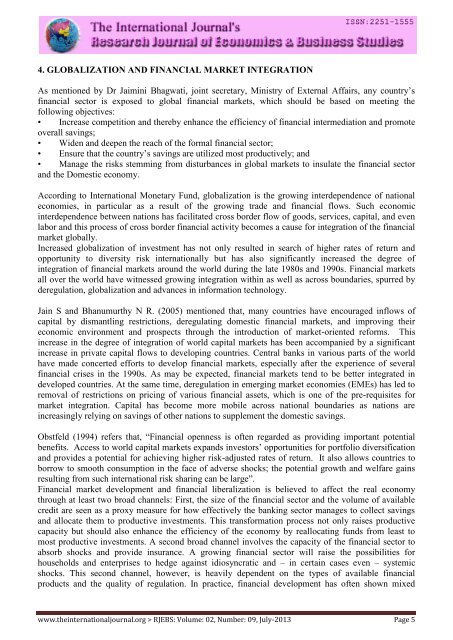Research Journal of Economics & Business Studies - RJEBS - The ...
Research Journal of Economics & Business Studies - RJEBS - The ...
Research Journal of Economics & Business Studies - RJEBS - The ...
Create successful ePaper yourself
Turn your PDF publications into a flip-book with our unique Google optimized e-Paper software.
4. GLOBALIZATION AND FINANCIAL MARKET INTEGRATION<br />
As mentioned by Dr Jaimini Bhagwati, joint secretary, Ministry <strong>of</strong> External Affairs, any country’s<br />
financial sector is exposed to global financial markets, which should be based on meeting the<br />
following objectives:<br />
• Increase competition and thereby enhance the efficiency <strong>of</strong> financial intermediation and promote<br />
overall savings;<br />
• Widen and deepen the reach <strong>of</strong> the formal financial sector;<br />
• Ensure that the country’s savings are utilized most productively; and<br />
• Manage the risks stemming from disturbances in global markets to insulate the financial sector<br />
and the Domestic economy.<br />
According to International Monetary Fund, globalization is the growing interdependence <strong>of</strong> national<br />
economies, in particular as a result <strong>of</strong> the growing trade and financial flows. Such economic<br />
interdependence between nations has facilitated cross border flow <strong>of</strong> goods, services, capital, and even<br />
labor and this process <strong>of</strong> cross border financial activity becomes a cause for integration <strong>of</strong> the financial<br />
market globally.<br />
Increased globalization <strong>of</strong> investment has not only resulted in search <strong>of</strong> higher rates <strong>of</strong> return and<br />
opportunity to diversity risk internationally but has also significantly increased the degree <strong>of</strong><br />
integration <strong>of</strong> financial markets around the world during the late 1980s and 1990s. Financial markets<br />
all over the world have witnessed growing integration within as well as across boundaries, spurred by<br />
deregulation, globalization and advances in information technology.<br />
Jain S and Bhanumurthy N R. (2005) mentioned that, many countries have encouraged inflows <strong>of</strong><br />
capital by dismantling restrictions, deregulating domestic financial markets, and improving their<br />
economic environment and prospects through the introduction <strong>of</strong> market-oriented reforms. This<br />
increase in the degree <strong>of</strong> integration <strong>of</strong> world capital markets has been accompanied by a significant<br />
increase in private capital flows to developing countries. Central banks in various parts <strong>of</strong> the world<br />
have made concerted efforts to develop financial markets, especially after the experience <strong>of</strong> several<br />
financial crises in the 1990s. As may be expected, financial markets tend to be better integrated in<br />
developed countries. At the same time, deregulation in emerging market economies (EMEs) has led to<br />
removal <strong>of</strong> restrictions on pricing <strong>of</strong> various financial assets, which is one <strong>of</strong> the pre-requisites for<br />
market integration. Capital has become more mobile across national boundaries as nations are<br />
increasingly relying on savings <strong>of</strong> other nations to supplement the domestic savings.<br />
Obstfeld (1994) refers that, “Financial openness is <strong>of</strong>ten regarded as providing important potential<br />
benefits. Access to world capital markets expands investors’ opportunities for portfolio diversification<br />
and provides a potential for achieving higher risk-adjusted rates <strong>of</strong> return. It also allows countries to<br />
borrow to smooth consumption in the face <strong>of</strong> adverse shocks; the potential growth and welfare gains<br />
resulting from such international risk sharing can be large”.<br />
Financial market development and financial liberalization is believed to affect the real economy<br />
through at least two broad channels: First, the size <strong>of</strong> the financial sector and the volume <strong>of</strong> available<br />
credit are seen as a proxy measure for how effectively the banking sector manages to collect savings<br />
and allocate them to productive investments. This transformation process not only raises productive<br />
capacity but should also enhance the efficiency <strong>of</strong> the economy by reallocating funds from least to<br />
most productive investments. A second broad channel involves the capacity <strong>of</strong> the financial sector to<br />
absorb shocks and provide insurance. A growing financial sector will raise the possibilities for<br />
households and enterprises to hedge against idiosyncratic and – in certain cases even – systemic<br />
shocks. This second channel, however, is heavily dependent on the types <strong>of</strong> available financial<br />
products and the quality <strong>of</strong> regulation. In practice, financial development has <strong>of</strong>ten shown mixed<br />
www.theinternationaljournal.org > <strong>RJEBS</strong>: Volume: 02, Number: 09, July-2013 Page 5
















